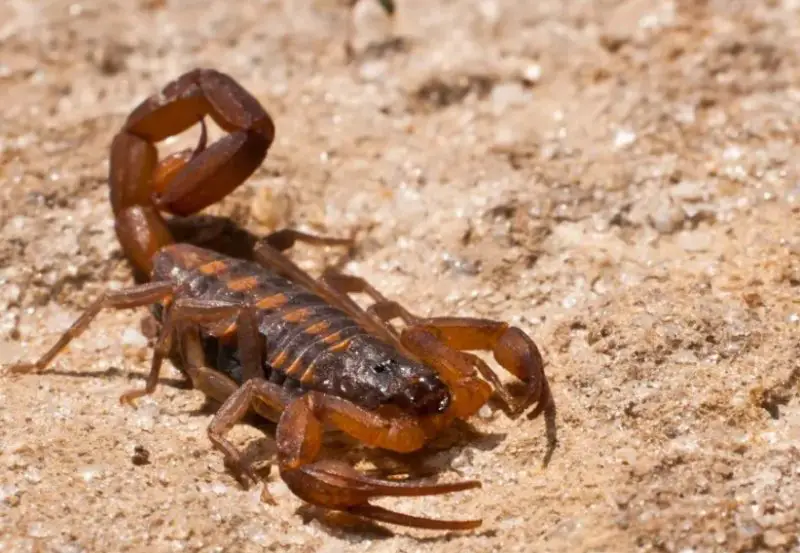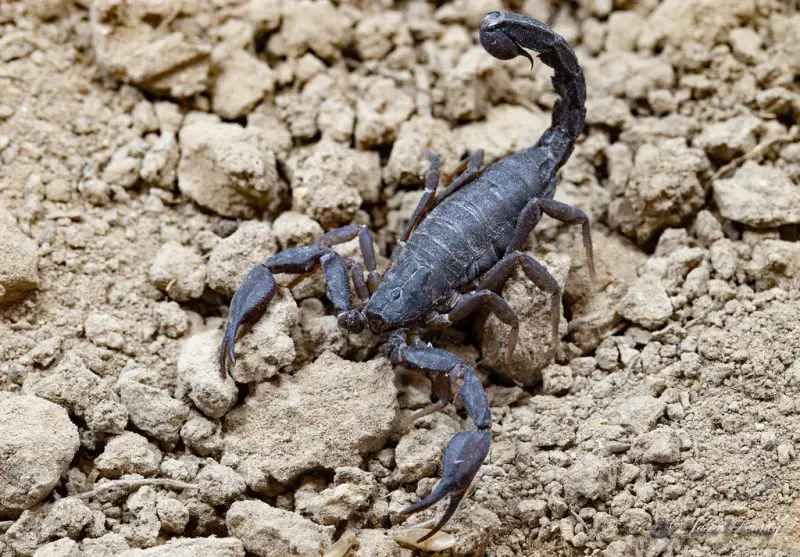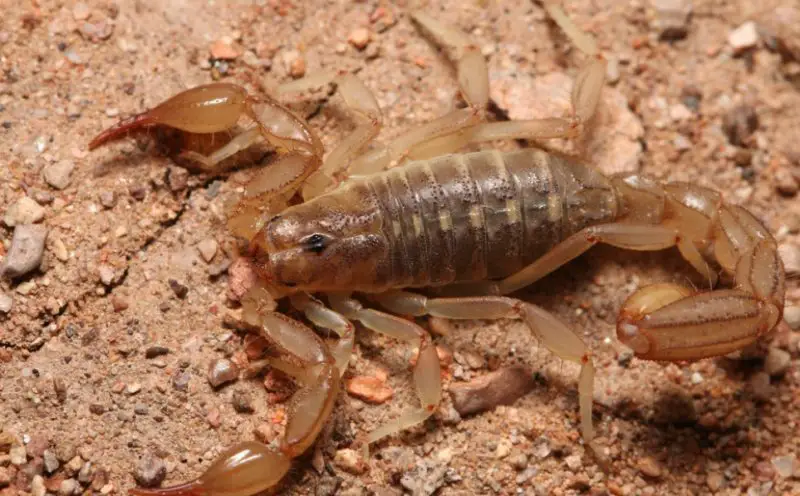Scorpions might not be the first creatures that come to mind when thinking of Oklahoma, but they are definitely part of the local wildlife. While they often stay hidden, these small arachnids can sometimes be found under rocks, in woodpiles, or even inside homes during warmer months.
Oklahoma is home to a few different scorpion species, but only one is commonly seen across the state. The others are rare and usually found in specific areas like caves or forested hills. Knowing how to identify them can help you avoid unwanted surprises and stay safe.
In this guide, you’ll learn about the three scorpion species found in Oklahoma. We’ll cover their appearance, behavior, venom, and where you’re most likely to spot them—with clear pictures to help you recognize each one.
Different Types of Scorpions in Oklahoma
Striped Bark Scorpion (Centruroides vittatus)

The Striped Bark Scorpion is the most widespread and commonly encountered scorpion species in Oklahoma. It has a slender, elongated body that ranges in color from pale yellow to light tan, with two distinctive dark stripes running longitudinally along its back. The tail is narrow and curves forward in the characteristic scorpion shape, ending in a bulbous stinger. Adults typically measure between 2.5 and 3 inches in length, and their pincers are thin and delicate compared to some bulkier scorpion species. When viewed under ultraviolet light, they glow a bright bluish-green, which is useful for nighttime detection.
This species is known for its secretive, nocturnal behavior. During the day, it hides under loose bark, rocks, woodpiles, and other ground debris. At night, it emerges to hunt for insects, spiders, and other small arthropods. The Striped Bark Scorpion is a surprisingly skilled climber and is often found on trees, fences, or even walls and ceilings inside buildings. In warm seasons, it may enter homes in search of prey or shelter, making it one of the few scorpions in the region that regularly comes into contact with humans. Its adaptability to both rural and suburban environments explains its dominance in the region.
The venom of Centruroides vittatus is not considered life-threatening to healthy individuals but can be quite painful. A sting often results in a sharp, burning sensation similar to a bee or wasp sting, followed by localized swelling, redness, and in some cases, temporary numbness. While serious allergic reactions are rare, they can occur, especially in sensitive individuals, children, or the elderly. For most people, the symptoms subside within a few hours without medical intervention, though pain management may be necessary. This species uses its sting primarily to subdue prey or as a last defense when threatened or handled.
Throughout Oklahoma, the Striped Bark Scorpion has established itself in a wide variety of ecosystems, ranging from dry grasslands and scrublands to forested edges and urban gardens. It is particularly abundant in central and southern parts of the state but can be found in nearly all counties. Due to its versatility and resilience, it remains the only scorpion species that residents of Oklahoma are likely to see frequently, whether in rural fields, state parks, or even inside their homes. Its presence is so prevalent that many pest control companies in the region specifically include bark scorpion management in their services.
Texas Cave Scorpion (Pseudouroctonus reddelli)

The Texas Cave Scorpion is a much more elusive species and is rarely seen in Oklahoma, though it is believed to inhabit the southernmost counties near the Texas border. This scorpion has a darker and more robust appearance than the Striped Bark Scorpion, with a deep reddish-brown to almost black exoskeleton and a stout, compact body. Adults usually measure between 1.5 to 2 inches in length. Its pincers are thick and powerful, designed more for grasping prey than for delicate manipulation. It lacks the distinct striping found in bark scorpions, and its darker coloration helps it blend into shadowy cave environments.
This species is strongly associated with caves, limestone outcroppings, and other moist, rocky habitats. It prefers areas that retain humidity and maintain relatively stable temperatures, such as deep crevices in rock faces or sheltered cracks within cliff systems. It is nocturnal and reclusive, emerging at night to hunt small insects, millipedes, and other cave-dwelling invertebrates. Unlike bark scorpions, Texas Cave Scorpions are not known to enter human structures, which further limits their visibility and makes encounters quite rare. Their behavior is generally shy and non-aggressive, avoiding light and vibration.
The sting of Pseudouroctonus reddelli is considered mild in comparison to other scorpions. While a sting can cause localized pain and discomfort, it is not known to cause serious medical effects in healthy individuals. The species relies heavily on its pincers for capturing prey and typically uses its sting only when threatened. Because of its limited interaction with people and natural avoidance of populated areas, it is not regarded as a public health concern. The venom itself contains no neurotoxins or compounds known to produce systemic symptoms in humans.
In Oklahoma, the Texas Cave Scorpion’s presence has been documented sporadically in southern counties along the Red River and in regions with karst formations or rocky hillsides, particularly in the southern Arbuckle Mountains. However, it is significantly more abundant in central and western Texas, which remains its primary habitat range. Oklahoma populations are likely small and localized, possibly limited to undisturbed wild areas. Due to its reclusive nature and habitat preferences, this species is of greater interest to biologists and spelunkers than to the general public and remains one of Oklahoma’s most rarely seen arachnids.
Lesser Stripetail Scorpion (Vaejovis carolinianus)

The Lesser Stripetail Scorpion, also known as the Southern Devil Scorpion, is a native of the southeastern United States and may occur in eastern Oklahoma, particularly in mountainous or forested regions such as the Ouachita Mountains. It is a medium-sized scorpion, growing between 1 and 2 inches in length, and is characterized by its dark brown or reddish-brown body and rough, granular surface texture. Unlike the Striped Bark Scorpion, this species lacks bold striping, and its tail segments appear slightly more robust and ridged, with subtle striping patterns on the underside of its tail.
This scorpion is highly reclusive and favors damp, shaded environments. It shelters under bark, rocks, and leaf litter during the day and becomes active at night to search for small invertebrates. Unlike some other scorpions that tolerate drier conditions, the Lesser Stripetail prefers moist forest floors, often near streams, springs, or rotting wood. It rarely enters human structures and generally stays in undisturbed natural areas. Its presence in Oklahoma is limited, but it may thrive in microhabitats where sufficient cover and humidity are available, especially in forested hills with rich undergrowth.
The sting of Vaejovis carolinianus is mild and typically results in only minor irritation, similar to a mild insect bite. Most stings do not require medical treatment unless the person stung has a known sensitivity. This species is not aggressive and will usually retreat when disturbed. If handled roughly, it may sting defensively, but even then, the effects are localized and short-lived. Because it relies more on its physical strength and pincers for subduing prey, its venom plays a secondary role in its hunting strategy and is not known to pose a threat to humans or pets.
Reports of the Lesser Stripetail Scorpion in Oklahoma are uncommon, and it is more frequently found in neighboring states such as Arkansas, Tennessee, Georgia, and the Carolinas. However, the eastern edge of Oklahoma shares some of the same wooded, humid terrain that this species prefers, making its presence possible in those regions, especially in Le Flore or McCurtain counties. Its rarity and secretive habits make it difficult to study or observe directly, and it is often discovered only through targeted biological surveys or by accident during fieldwork in damp woodland environments.
Scorpions in Oklahoma – Identification & Comparison Table
Feature |
Striped Bark Scorpion(Centruroides vittatus) |
Texas Cave Scorpion(Pseudouroctonus reddelli) |
Lesser Stripetail Scorpion(Vaejovis carolinianus) |
|---|---|---|---|
Adult Size |
2.5–3 inches (6–7.5 cm) |
1.5–2 inches (4–5 cm) |
1–2 inches (2.5–5 cm) |
Coloration |
Pale yellow/tan with two dark stripes on back |
Dark reddish-brown to black |
Dark brown to reddish-brown |
Pincer Shape |
Long and slender |
Thick and strong |
Short, thick, more robust |
Tail Appearance |
Slender, long, smooth segments |
Shorter, thick segments |
Slightly ridged and more textured tail |
Venom Potency |
Moderate (painful sting, rarely dangerous) |
Mild (localized pain, no medical concern) |
Mild (similar to insect bite, non-threatening) |
Aggressiveness |
Low; may sting when disturbed |
Very low; shy and avoids contact |
Very low; rarely stings unless handled |
Climbing Ability |
Very good climber – often enters homes |
Poor climber – stays in caves and rocks |
Poor climber – remains on forest floor |
Habitat Preference |
Wide variety: grasslands, woodlands, urban areas |
Caves, rocky outcrops, humid shelters |
Moist forests, leaf litter, near water |
Common Location in OK |
Throughout the state; most common species |
Rare – south Oklahoma, near Texas border |
Rare – far eastern OK (Ouachita region) |
Human Encounters |
Frequent (especially in warm months indoors/outdoors) |
Very rare |
Very rare |
UV Fluorescence |
Yes – glows under UV light |
Yes – glows under UV light |
Yes – glows under UV light |
FAQs about Scorpions in Oklahoma
Are scorpions common in Oklahoma?
Yes, scorpions are relatively common in Oklahoma, particularly in the central and southern regions. The most frequently encountered species is the Striped Bark Scorpion (Centruroides vittatus), which is widely distributed across the state and often enters homes during warmer months.
What is the most common scorpion in Oklahoma?
The Striped Bark Scorpion is the most common and widespread species in Oklahoma. It is easily recognizable by its pale yellow body with two dark stripes running down its back. This species is known for its adaptability to both wild and urban environments.
Are scorpions in Oklahoma dangerous?
Scorpions in Oklahoma are not considered highly dangerous. While their stings can be painful, they are usually not life-threatening. The Striped Bark Scorpion delivers a sting similar to a bee or wasp. Severe reactions are rare but possible in people with allergies or compromised immune systems.
Where do scorpions live in Oklahoma?
Scorpions prefer dark, sheltered environments such as under rocks, logs, bark, and leaf litter. In Oklahoma, they are found in grasslands, woodlands, rocky outcrops, and even inside homes. They are most active during warm, humid nights.
When are scorpions most active in Oklahoma?
Scorpions are most active from late spring through early fall, especially during the hot summer months. They are nocturnal hunters and typically emerge after dusk in search of insects and other small prey.
Do Oklahoma scorpions glow under UV light?
Yes, all scorpions, including those found in Oklahoma, fluoresce under ultraviolet (UV) light. This glowing effect makes them easier to spot at night using a blacklight flashlight.
Can scorpions climb walls or enter houses?
Yes, the Striped Bark Scorpion is an excellent climber and can scale walls, trees, and even ceilings. It may enter homes through gaps, windows, or vents in search of prey or shelter, especially during hot or dry weather.
What should I do if I get stung by a scorpion in Oklahoma?
If you are stung by a scorpion, clean the area with soap and water, apply a cold compress, and monitor for symptoms. Pain, swelling, and redness are common. If you experience difficulty breathing, muscle twitching, or signs of an allergic reaction, seek medical attention immediately.
Are there any rare scorpion species in Oklahoma?
Yes, in addition to the common Striped Bark Scorpion, two other species may be present in Oklahoma: the Texas Cave Scorpion (Pseudouroctonus reddelli) in the southern border regions, and the Lesser Stripetail Scorpion (Vaejovis carolinianus) in forested areas of eastern Oklahoma. These species are rarely encountered and are not considered threats to humans.
How can I prevent scorpions from entering my home in Oklahoma?
To prevent scorpions from entering your home, seal cracks around doors, windows, and foundations. Keep firewood, rocks, and debris away from the house, and reduce moisture and clutter inside. Installing door sweeps and screens can also help block their entry.






